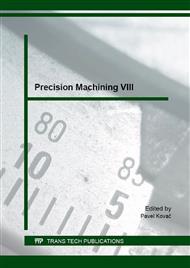[1]
M.A. Salgado, L.N. Lopez de Lacalle, A. Lamikiz, J. Munoa, J.A. Sanchez, Evaluation of the stiffness chain on the deflection of end-mills under cutting forces, International Journal of Machine Tools & Manufacture 45 (2005) 727–739.
DOI: 10.1016/j.ijmachtools.2004.08.023
Google Scholar
[2]
B.C. Shin, S.J. Ha, M.W. Cho, T.I. Seo, G.S. Yoon, Y.M. Heo, Indirect cutting force measurement in the micro end-milling process based on frequency analysis of sensor signals, The Journal of Mechanical Science and Technology 24, 1 (2010) 165-168.
DOI: 10.1007/s12206-009-1121-x
Google Scholar
[3]
W. Zębala, Tool stiffness influence on the chosen physical parameters of the milling process, Bulletin of the Polish Academy of Science -Technical Sciences 60, 3 (2012) 597-604, DOI: 10. 2478/v10175-012-0071-0.
DOI: 10.2478/v10175-012-0071-0
Google Scholar
[4]
C.G. Sim, M.Y. Yang, The prediction of the cutting force in ball end milling with a flexible cutter, International Journal of Machine Tools & Manufacture 33, 2 (1993) 267–284.
DOI: 10.1016/0890-6955(93)90079-a
Google Scholar
[5]
V.S. Rao, P.V.M. Rao, Tool deflection compensation in peripheral milling of curved geometries, International Journal of Machine Tools & Manufacture 46 (2006) 2036–(2043).
DOI: 10.1016/j.ijmachtools.2006.01.004
Google Scholar
[6]
B. Mikó, J. Beňo, Effect of the Working Diameter to the Surface Quality in Free-form Surface Milling, Key Engineering Materials 581 (2014) 372-377.
DOI: 10.4028/www.scientific.net/kem.581.372
Google Scholar
[7]
A. Larue, B. Anselmetti, Deviation of a machined surface in flank milling, International Journal of Machine Tools & Manufacture 43 (2003) 129–138.
DOI: 10.1016/s0890-6955(02)00189-x
Google Scholar
[8]
E.J.A. Armarego, N.P. Deshpande, Computerized end-milling force predictions with cutting models allowing for eccentricity and cutter deflections, Annals of the CIRP 40 (1991) 25–29.
DOI: 10.1016/s0007-8506(07)61926-x
Google Scholar
[9]
B.W. Ikua, H. Tanaka, F. Obata, S. Sakamoto, K. Takeyasu, I. Tatsuo, Prediction of cutting forces and machining error in ball end milling of curved surfaces—2 Experimental verification, precision engineering, Journal of the International Societies for Precision Engineering and Nanotechnology 26 (2002).
DOI: 10.1016/s0141-6359(01)00101-5
Google Scholar
[10]
G. Stépán, Retarded dynamical systems: Stability and characteristic functions. Longman, Harlow, UK (1989).
Google Scholar
[11]
A.C. Lee, C.S. Liu, S.T. Chiang, Analysis of chatter vibration in a cutter-workpiece system, International Journal of Machine Tools & Manufacture 31, 2 (1991) 221–234.
DOI: 10.1016/0890-6955(91)90006-o
Google Scholar
[12]
R. Rusinek, J. Warmiński, K. Szabelk, Drgania nieliniowe w procesie skrawania toczeniem. IZT Sp. z o. o., Lublin, Poland (2006).
Google Scholar
[13]
W. Zębala, B. Słodki, G. Struzikiewicz, Productivity and reliability improvement in turning inconel 718 alloy - case study, Eksploatacja i Niezawodnosc-Maintenance and Reliability 15, 4 (2013) 421-426.
Google Scholar
[14]
W. Zębala, R. Kowalczyk, Cutting Data Influence on Cutting Forces and Surface Finish During Sintered Carbide Turning, Key Engineering Materials 581 (2014) 148-153.
DOI: 10.4028/www.scientific.net/kem.581.148
Google Scholar
[15]
J. Beňo, I. Maňková, M. Vrabeľ, D. Kottfer, Roughness measurement methodology for selection of tool inserts, Measurement 46, 1 (2013) 582-592.
DOI: 10.1016/j.measurement.2012.08.017
Google Scholar
[16]
G. Struzikiewicz, T. Otko, Dependence of shape deviations and surface roughness in the hardened steel turning, Key Engineering Materials 581 (2014) 443-448.
DOI: 10.4028/www.scientific.net/kem.581.443
Google Scholar
[17]
R.W. Maruda, S. Legutko, G.M. Krolczyk, P. Raos, Influence of cooling conditions on the machining process under MQCL and MQL conditions, Tehnički Vjesnik – Technical Gazette 22, 4 (2015) 965-970.
DOI: 10.17559/tv-20140919143415
Google Scholar
[18]
G. Varga, J. Kundrák, Effect of environmentally conscious machining on machined surface quality, Applied Mechanics and Materials 309 (2013) 35-42.
DOI: 10.4028/www.scientific.net/amm.309.35
Google Scholar
[19]
J. Kundrák, G. Varga, Possibility of reducing environmental load in hard machining, Key Engineering Materials 496 (2012) 205-210.
DOI: 10.4028/www.scientific.net/kem.496.205
Google Scholar
[20]
R.W. Maruda, E. Feldshtein, S. Legutko, G.M. Krolczyk, Analysis of contact phenomena and heat exchange in the machining zone under Minimum Quantity Cooling Lubrication conditions, Arabian Journal for Science and Engineering, (2015).
DOI: 10.1007/s13369-015-1726-6
Google Scholar
[21]
User's Manual of AdvantEdge v5. 6 machining simulation software, Minneapolis, MN (2010).
Google Scholar
[22]
R. Boyer, G. Welsch, E.W. Collings, Material properties handbook: titanium alloys. ASM International, Materials Park, OH, USA (1994).
Google Scholar
[23]
A. l. Zkeri, J. Rech, T. Altan, H. Hamdi, F. Valiorgue, Optimization of the cutting edge geometry of coated carbide tools in dry turning of steels using a finite element analysis, Machining Science and Technology 13 (2009) 36–51.
DOI: 10.1080/10910340902776051
Google Scholar


